Pride and prejudice: Scotland's complicated black history
- Published
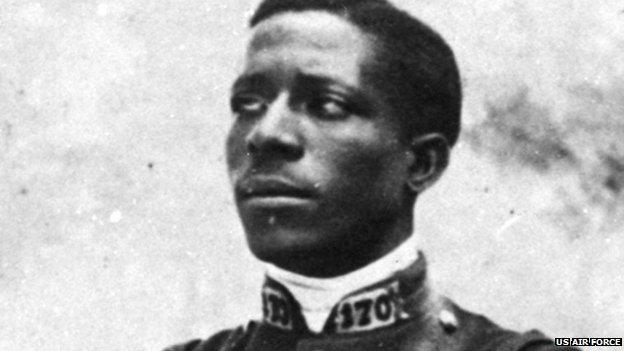
Eugene Bullard, America's first combat pilot, fled to Scotland to escape racial hatred in the US
October is Black History Month, an event first marked in the UK 25 years ago. Scotland has close associations with the black African and Caribbean communities it celebrates.
Black History Month has been held annually in the US since the 1920s and in the UK from the late 80s.
It is a celebration of the contribution that black African and Caribbean communities have made on a local level and across the world.
Hackney, London, is where it all started in British terms and the London borough is holding various events to mark the 25th anniversary, external.
Scotland's black history is populated by interesting and important characters, many of whom had to endure prejudice and racism. But who were some of these people?
Shipwreck survivors
On the bottom of Eddrachillis Bay near Drumbeg, in Sutherland, lie three cannon and part of a wooden hull of an age-old ship.
Archaeologists believe it could be the remains of a Dutch vessel that got into difficulty off Scotland's remote north-west Highland coast between 1650 and 1750.

A diver inspects one of the three cannon found in Eddrachillis Bay
One theory is that the vessel was owned by the Dutch East India Company, also known as VOC.
Founded in 1602, it was the world's biggest and most powerful trading company until it collapsed in financial ruin in 1799.
Its vessels regularly sailed around the north of Scotland because of the favourable winds and also to avoid the English Channel, particularly at times of war and tensions in Europe.
The cannon could have been used by the Drumbeg ship's crew to ward off privateers, privately-owned armed vessels commissioned by a state to attack an enemy's shipping.
And it has been suggested some or all of the crew may have survived their ordeal.
There is possible evidence of foreign sailors setting up home in the north of Scotland after their vessel foundered off the Sutherland coast.
The First Statistical Account of Scotland published between 1791 and 1799 records how the climate of the area was pleasant enough for "natives of the East and West Indies" to live there.
Philip Robertson, a Historic Scotland marine archaeologist, told BBC Scotland in March that the origins of the Drumbeg crew, and their fate, was still unknown.
But he added: "The wreck gives us a unique window into our history and, interestingly, the trading activity off the Scottish coastline and across the world."
Slaves
Scots were heavily involved in the slave trade of the 18th and 19th Centuries, something which leading historian Prof Tom Devine has accused Scotland of ignoring today, external.
Men and women were put to work in Scots-run plantations in the colonies. Female slaves were also sexually abused by their owners.
An exhibition on slavery held in 2011 involving the Centre for History in Dornoch and Edinburgh Beltane organisation featured correspondence detailing the keeping of sex slaves.
The letters were sent by Highland owners to relatives in Inverness and their contents were described as "graphic" and "disturbing" by researchers.
Scotland's slave past is also recorded in other sources.

A close up of the mystery figure at Culloden who appears on the right edge of the tapestry
In 2007, historians were intrigued by a mysterious black figure who appears in a tapestry depicting the Battle of Culloden of 16 April 1746.
Some at experts at the National Trust for Scotland had a theory that he may be a Jamaican servant of an officer on the government side.
Little is known of the 18th Century needlework, and the trust said it was not clear if the tapestry was a true depiction of a scene from the battle, or one featuring later influences.
Fossil hunter
Papers in the JLM Mitchell Archive of the Gaelic Society of Inverness, meanwhile, include a Scottish soldier's request to take his daughter Mary's black slave with him to war in 1782.
Lt Soirle MacDonald, from Skye, was a British Army officer in the American War of Independence.
His daughter's slave was called Doll. She was likely to have been made to do domestic duties.
Records detailing compensation paid by the British government to slave owners after slavery was abolished mention Gen Sir James Duff, an army officer and MP for Banffshire.
He was awarded £4,101, more than £3m in today's money, external, to compensate him for the 202 slaves he was forced by law to give up on the Grange Sugar Estate in Jamaica.
David Alston, a local historian and Highland councillor, has also examined slavery.
He was drawn to the subject after discovering that fossil hunter, geologist and writer Hugh Miller sat next to a black pupil in the school he attended in Cromarty.
Dr Alston said: "I gradually noticed more and more local connections with the Caribbean, including references on gravestones.
"Slowly it became clear just how many Highland Scots had connections to slave-worked plantations and how many children were born to these Highlanders and either enslaved or 'free coloured' women."
Further research led Dr Alston to find that almost every prominent school in the Highlands had black pupils on its roll at some time between 1790 and 1830.
He said: "I keep my research very focussed on the three former Dutch colonies which later became British Guiana, now Guyana, on the north coast of South America.
"Almost everyone will recognise the name of one of the colonies - Demerara.
"I have now identified almost 450 people with Highland connections involved in the plantation of Guyana before emancipation of slaves in 1834."
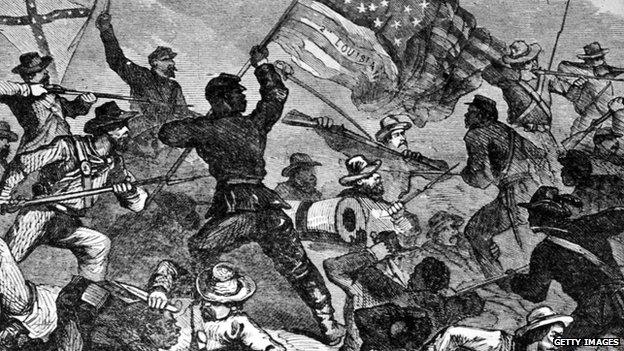
Scots fought against slavery serving with Union forces in the American Civil War
But Scots also fought against slavery.
They served in the Union army in the American Civil War of 1861-65. Slavery was among issues that divided American society at the time, and led to a violent conflict.
Lt Col William L Duff, Sgt Maj John McEwan, Robert Steedman, James Wilkie, Robert Ferguson and Alexander Smith are listed on a civil war memorial in Edinburgh.
Other Scots who fought for the Union included Glasgow-born John McTammany, who served in the 115th Ohio volunteers.
Another was George Henry Mackenzie, who was born 175 years ago in North Kessock, a small community across the Beauly Firth from Inverness.
As a captain, he led Black Union soldiers.
Sports stars
Football was where two key figures in Scotland's black history excelled in the face of extreme prejudice in the late 1800s.
Carrie Boustead played in goals for a number of teams including Mrs Graham's XI, a women's team set up by Helen Matthew, the daughter of a Montrose-born master mariner.
Richard McBrearty, of the Scottish Football Museum, said: "A degree of mystery surrounds Carrie Boustead.
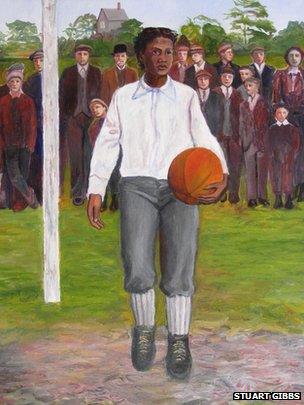
Carrie Boustead in a painting by artist Stuart Gibbs
"It is believed that Carrie Boustead was originally known as Clara Berry and was raised in Liverpool during the 1870s.
"Carrie first comes to prominence in 1896 when she played in a series of football matches north and south of the border."
Boustead was in goals for a London team that played at Barrowfield Park in Glasgow in May 1896, and also in a game held in Stirling.
She was listed as being goalkeeper for Mrs Graham's XI in a match played at Wishaw in Lanarkshire.
Boustead is among women footballers of the 1800s portrayed in paintings by Scots artist Stuart Gibbs.
Mr McBrearty said: "At a time when there was widespread cynicism towards women playing football, Boustead was a successful proponent of the women's game and she, along with her team mates of the period, should be remembered for their achievements north and south of the border as pioneers."
'Greatest defenders'
While much of Boustead's life is a mystery, the career of Andrew Watson, Scotland's first black international footballer, is well documented.
Mr Brearty said: "Watson was one of the greatest defenders of his generation.
"He played in three of the greatest and most high profile teams of the 1880s - Queen's Park FC, Corinthians, and Scotland."
Watson, who was born in Georgetown, British Guiana, and whose father was a plantation manager and former slave owner from Orkney, played for Scotland at a time when they dominated international football.
His three caps for Scotland were a 6-1 and 5-1 win over England and a 5-1 win over Wales.
Mr Brearty said: "On his debut in 1881 he captained Scotland to a 6-1 win over England at the Oval in London - this remains England's heaviest defeat on home soil."
He added: "Watson only won three caps because he moved away from Scotland and down to London in 1882 and was beyond the gaze of the international selectors.
"While in London in 1882 he played for the London Swifts in an FA Cup match and became the first known black footballer to play in the FA Cup.
"He is the first black international footballer and international football captain."
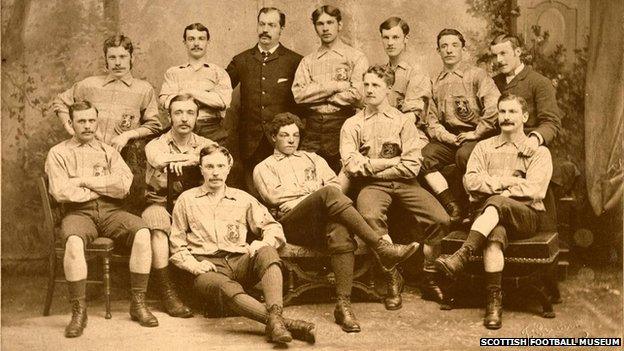
Watson, sitting middle, as captain of Scotland prior to the 1881 international match with England
England's Corinthians included a few non-English players. Watson was the first of those footballers and he played in the team's 8-1 win over reigning FA Cup holders Blackburn Rovers in 1884.
But Watson's star qualities on the pitch did not protect him from racial abuse.
Mr McBrearty said: "The Scottish Athletic Journal provided an overview of his career in 1885.
"It stated: 'Although on more than one occasion subjected to vulgar insults by splenetic, ill-tempered players, he uniformly preserved that gentlemanly demeanour which has endeared him to opponents as well as his club companions'.
"This suggests that he experienced racism on the field, but that he was able to rise above insults and let his sporting ability shine through on the park."
But he added: "One of the best complements to Watson's ability can be found in his selection in an all-star Scotland team in 1926. JAH Catton, editor of the Athletic News, selected Watson at left back in his all-time Scotland team, 44 years after his last Scotland appearance."
Air ace
Eugene Bullard - America's first black combat pilot - must rate among one of the most unusual characters from Scotland's black history.
Georgia-born Bullard's ancestors included slaves from Martinique who were brought to America by their French owners as they fled the Haitian slave revolution.
His father spoke French and also talked fondly of France, instilling in Bullard a belief that it was the true land of opportunity, free of prejudice.
Spurred by an attempt to lynch his father and his own brushes with racial hatred, Bullard worked towards getting himself to Paris. This journey first took him to Scotland.
According to Craig Lloyd's book Eugene Bullard: Black Expatriate in Jazz-Age Paris, Bullard was barely in his teens when he stowed away on a German cargo ship at Norfolk, Virginia.
The captain of the Marta Russ first threatened to throw Bullard overboard, before giving him the chance of working on the ship on its passage to Aberdeen.
Bullard left his ship shortly after it reached Aberdeen. He spent a day in the Granite City before taking a train to Glasgow.
While he was relieved to find he was not the target of vicious racial abuse in Scotland, Lloyd said that Bullard did have one immediate problem.
Lloyd wrote: "At first he had difficulty with the Scottish dialect and accent: 'the language the natives spoke was sort of like English'."
Bullard spent five months in Glasgow and earned money acting as a lookout at illegal gambling dens.
He later headed for Liverpool and then finally France.
In World War I, he served with the French Foreign Legion and saw action at some of the bloodiest battles, including the Somme and Artois Ridge.
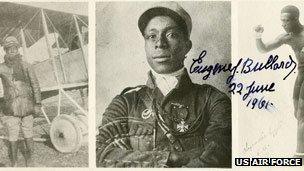
Eugene Bullard spent time in Aberdeen and Glasgow
Wounds he suffered at Verdun ruled him out from returning to the front line as a soldier, but he was offered a chance to become a pilot with the French Flying Corps.
In 1917, he qualified as a flyer. He earned one officially confirmed kill.
When the US entered the war, Bullard sought a transfer to its air force. His request was ignored.
Bullard remained in Paris after the war.
He became part-owner of a night club, got married and had three children.
During World War II, he fought with the French resistance until he was badly wounded and was smuggled into Spain.
Thirty-three years after his death in 1961 the US Air Force posthumously commissioned him as a lieutenant in honour of his war-time exploits.
- Published26 September 2013
- Published4 June 2012
- Published5 December 2011